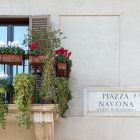The remembrance of past wars
The space seems immense, although it is probably about the same size as a football pitch. The traffic on the busy main road nearby seems miles away. The ugly urban sprawl beyond the trees is forgotten the moment you enter the gates.
There is something so unexpected about the Beach Head war cemetery a few miles north of Anzio that it takes your breath away. Set discretely back from the entrance there is row after row of simple, beautifully tended graves. This is the burial place of thousands of young men aged between 19 and 34. Most of them were killed between February and March 1944. They came from Britain (2,199), Canada (69), South Africa (25), Australia (6), New Zealand (5), India (5), and 3 from nobody knows where, and they never went home. It was always the practice that Commonwealth war dead were buried where they died.
The Beach Head cemetery is just one of three war cemeteries in the area that testify to the fierce fighting during those early months of 1944 when allied forces landed near Anzio and had to battle strong German defences before they could break out in May along the road to Rome. Just outside the town in the Anzio war cemetery are the graves of another 1,053 military from Commonwealth countries. Carry on to Nettuno about four kilometres away and the graves of 7,000 United States military who died in the fighting between Sicily and Rome are lined up under the evergreen trees.
The Commonwealth cemeteries in Anzio are just two of 51 throughout Italy. The US forces have one other, a short distance south of Florence, where over 4,000 lie buried.
The Commonwealth cemetery that residents in Rome will know best is close to the famous non-Catholic cemetery in Testaccio. Here 426 Commonwealth military are buried (360 British, 28 South Africans, 22 Canadians, 10 New Zealanders, 4 Australians and 2 from pre-independence India). But there are Commonwealth graves all over Italy, nearly 50,000 in total, from the Veneto in the north (mostly graves of soldiers who died in the first world war) to Sicily in the south.
These numbers represent only a fraction of those who lost their lives in north Europe in the two world wars. But what is very obvious from a visit to any Commonwealth cemetery is that it is not the numbers that are important but the individual who lies buried there. Each grave counts, each individual is remembered, even though family and relations may never have visited the site or may have stopped doing so long ago.
The headstones are uniform in size and shape and are easily distinguishable from the white cross or Star of David in the US cemeteries. But most have a regimental badge, and all of them have the name, age and date of death. In many cases there is a personal message from mother, father, brothers and sisters at the foot of the stone. The graves of unknown warriors carry the words: A soldier known unto God.
This atmosphere has not been brought about by chance. Behind each lovingly tended grave is a large organisation, the Commonwealth War Graves Commission, which manages over 900,000 graves in 150 countries. This year it celebrated its 85th anniversary, but there is nothing old- fashioned and stuffy about this organisation which could so easily have become a legacy of past empire or of another age.
The present director general, Richard Kellaway, has all the techniques of British management at his command. Head of the narcotics and tax evasion investigations at Customs and Excise until two years ago, Kellaway seems as versed in his job as someone who had been there for decades. With detailed knowledge at his fingertips, he also has the ability to transmit his enthusiasm and expertise to others. Anyone who thinks that the maintenance of war graves is a subject best left to the old-timers who lived through those terrible years only has to listen to Kellaway to know that this is not the case.
Far from being a forgotten subject, there has been an upsurge of interest in recent years, explains Kellaway. This is partly because schools now encourage the study of the two world wars in a more imaginative way and partly because of a new interest in family history thanks to geneaology sites on the internet. The commissions website, which has a search engine on its home page to locate the burial place of each individual in its care, gets about 50,000 hits a week. It has very recently installed a new link to the family records site (www.familyrecords.gov.uk) which makes tracing lost relatives even easier than before.
This is only one of the commissions many initiatives to maintain public awareness of its work, especially among the young. Then there is the need for constant maintenance of the cemeteries. Kellaway describes the use of modern techniques for the cleaning and the conservation of headstones. He mentions the cultivation of special grass for the cemeteries in arid climates. He talks about the best use of scarce water resources in desert sites. He outlines the programmes to train new staff and to ensure the health and safety of the commissions 1,200 employees.
In Italy there are 74 locally employed people, with five UK-based members of staff. There are mobile groups of gardeners and stone masons who cover the whole country, and some people have been working for the commission for up to 30 years. At the top of the organisation in Italy is a joint committee of Italians and Commonwealth members which was founded in 1953. Italy granted, and still owns, the land on which the cemeteries stand and guarantees it from encroachment by developers. The Commonwealth commission pays for all the maintenance. If they were not constantly maintained they would crumble away in six or seven years, says Kellaway. This can be a major headache in countries such as Iraq, where access is now difficult and where the upkeep of some of the many first world war cemeteries has not been possible for ten years.
If Kellaway makes the commission sound like the modern multinational organisation that it is, a visit to the cemeteries tells a much more personal and moving tale. The flowering shrubs at the head of each grave are placed with infinite care and with an acute sense of colour, shape and size. The trees, roses and wisteria are immaculately pruned, the grass is maintained and mown to military perfection. There isnt a weed to be seen, not even pushing through the artistically laid paving stones around the sites. On a damp autumn day there wasnt a fallen leaf left lying around or a lavender bush with a twiggy stalk out of place.
All the more surprising then that there wasnt a trace of a gardener one Friday afternoon in mid-October, no-one bending to weed the long rows of graves or to remove a withered flower. There was just an infinite sense of peace and perfection, as though an invisible hand were moving with loving dedication along the lines of graves.
In Rome, Remembrance Day is commemorated on 11 November. United States Memorial Day is on the last Monday in May.
ANZAC day is 25 April.
Commonwealth War Graves Commission, Viale Marinetti 221, 00143 Rome,
tel. 065099911. Website: www.cwgc.org.
American Battle Monuments website: www.abmc.gov.




















